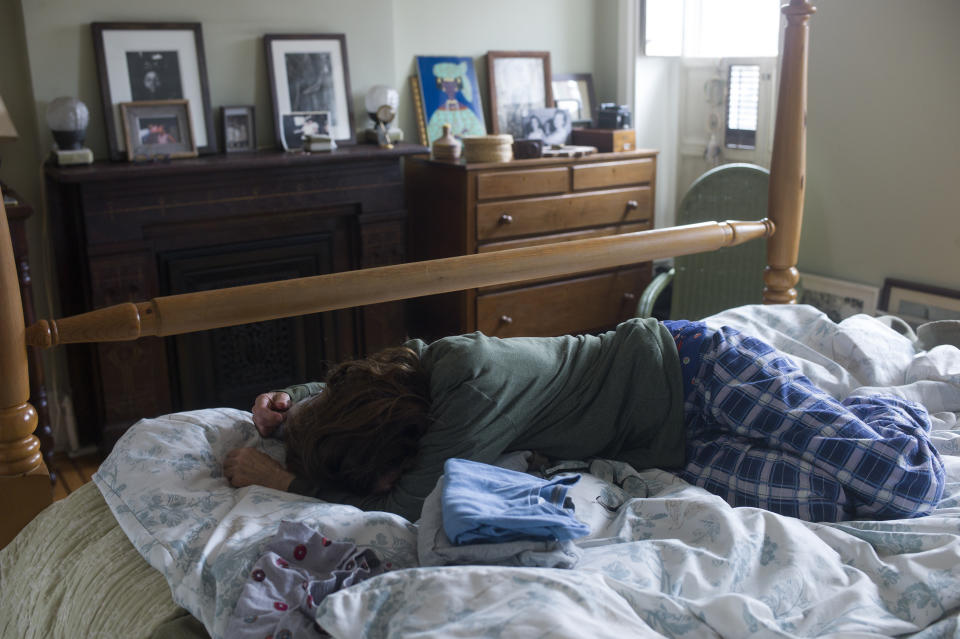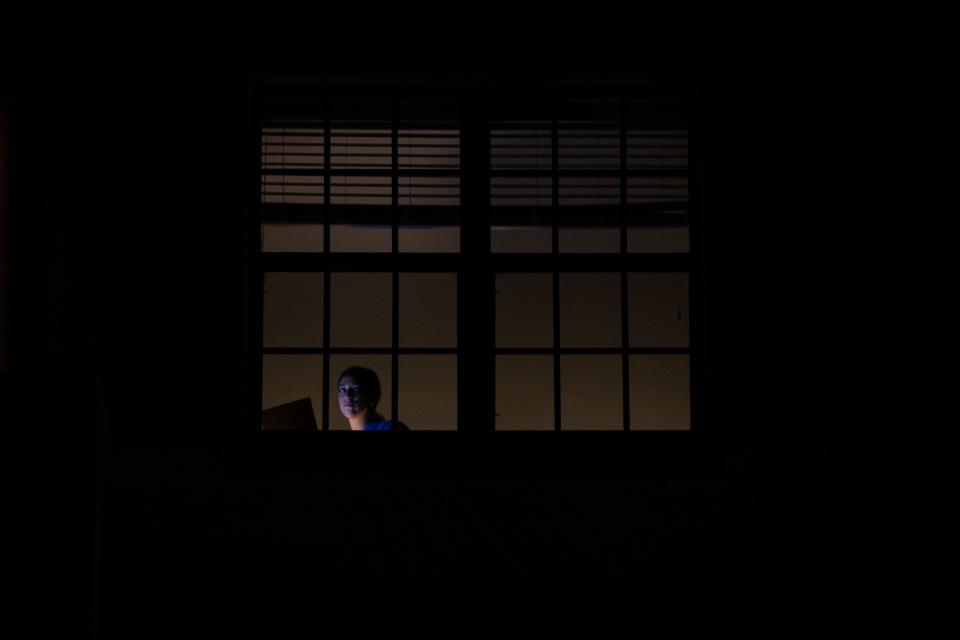How Americans' coronavirus worries and mental health issues have shifted during the pandemic
At 9 p.m., after she puts her twin fourth graders to sleep, Kristy Hixon logs on to hear about how strangers are struggling — and these days that often means hearing about the coronavirus pandemic.
The 40-year-old teacher in Fort Worth, Texas, has been working two-hour counseling shifts twice a week since last August. She has a master’s degree in school counseling and was looking for volunteer opportunities she could do from home to build practical experience. That led her to Crisis Text Line, an organization that has been providing free 24/7 crisis counseling via text message since 2014. Now, with the coronavirus pandemic ravaging the globe, the ability to receive emergency mental health care from isolation is more important than ever.
All someone needs to access the service is a cellphone. A text message to 741741 will prompt an automated message that includes a link to their terms of service and an invitation to explain their crisis. An algorithm sorts responses for triage. Certain words indicate a person is an immediate danger to themselves and will prompt an emergency response from a supervisor. The algorithm that detects this relies on machine learning, constantly refining itself.
But generally, a volunteer like Hixon is paired with a texter seeking help within five minutes.
During the pandemic, the volume of calls has skyrocketed. Before the coronavirus, Crisis Text Line was fielding between 2,800 and 3,500 conversations a day. Now that number is between 4,000 and 6,000 daily, according to data the organization provided to Yahoo Life. Hixon herself doesn’t experience that surge, however, as the number of volunteers has grown to accommodate the need. The organization used to have 5,000 counselors work in a given month; now that’s up to 10,000, it says. More people are applying to volunteer too. Before the pandemic, Crisis Text Line would get about 100 new applications every week. Lately, they’re seeing that many every single day.
Coronavirus worries come in waves
One in five people texting in mention COVID-19, says Ashley Womble, head of communications at Crisis Text Line and a volunteer counselor herself, “but there’s a vast array of things about COVID that they’re texting in about.”
And Crisis Text Line is tracking the specifics of that vast array, through keywords and demographic information. About half the organization’s staff members are supervisors who oversee counselor conversations, but the next largest group of employees is the data scientists. As a result, they have a trove of insight into the psyche of a country under quarantine, and a testament to the depth and breadth of the mental health crisis coming on the heels of the coronavirus. For weeks now, experts have warned of “a historic wave of mental health problems” resulting from the global pandemic — but one that’s manifesting individually and in isolation.

What’s valuable about the data is also what makes it overwhelming — it’s tracked granularly by week, age bracket, job status and race. But overarching trends do emerge.
In data provided to Yahoo Life by Crisis Text Line tracking how the coronavirus pandemic is making people feel, “constant worrying” and “feeling nervous” were down slightly between early April and the week of May 1. But in contrast, reports of feeling “depressed and hopeless” (69.17 percent of people texting about the pandemic) and “little interest in doing things” (62.36 percent) were both up about 2 percentage points.
This tracks with what Womble explained was the initial wave of anxiety giving way to a second wave of depression as the isolation of quarantine and other aggravating factors of the pandemic take their toll.
Last week, in an internal report on its own data, Crisis Text Line noted a dramatic uptick in conversations mentioning domestic violence (over 2,400 a week in May), sexual abuse (over 1,000 one week in May) and substance abuse (over 500 one week in May). A staggering 39 percent of texters under the age of 13 mentioned fear of or abuse by someone in their home as the source of their distress.
Crisis Text Line skews young by virtue of its interface. Young people are more comfortable receiving health care services via their cellphone screen and more likely to seek them that way. Even as the pandemic has inspired an uptick in older texters, the vast majority still come from Gen Z, with 75 percent of texters under 25 and 13 percent under 13. And the data on preteens is troubling. Texters under 13 were more likely than anyone over the age of 25 to report feeling lonely and/or isolated (82 percent) and were the most likely of any age cohort to report recent experiences of racism (13.5 percent). For Asian-Americans of all ages, that number is 31 percent.
Womble says the third wave will be what she calls the “scars of quarantine” — grief as the death toll from the pandemic rises, surpassing 100,000 in the U.S. this week, and economic anxiety as unemployment passes 40 million. The number of texters reporting the recent loss of a loved one has risen steadily (up to 14 percent in mid-May), but this month a higher percentage of people reported distress over financial concerns than fear of contracting the virus themselves.
During the week ending May 18, 62 percent of texters said they or someone in their household had lost their job due to the coronavirus, 76 percent said they were concerned about someone in their household losing their job and 80 percent were worried about being able to pay bills on time. Among texters who are unemployed, 72 percent reported feeling depressed and hopeless, according to Crisis Text Line data.

‘I’m right there with them’
For Hixon, each new conversation appears in a text box on her computer screen. It looks like any forum for digital communication you’re used to — one box for talking to someone in crisis and one for talking to her supervisor in case she becomes concerned that someone is going to hurt themselves imminently.
She’ll introduce herself and ask the texter if they’re comfortable sharing their name. She’ll say that they’re strong and courageous for seeking help, and over the next 35 to 45 minutes, they’ll talk about why the texter reached out today, what their goals are and what kind of coping mechanisms are available to them. Hixon will direct them to tangible resources for issues like unemployment, but mostly she’ll provide active listening and empathy.
Empathy is an especially interesting concept for Hixon right now as she helps people navigate the ongoing emotional fallout from the same pandemic that saw her scrambling to collect material from her classroom. The school where she teaches third grade allowed faculty back inside for a 10-minute stretch more than two months ago.
On the one hand, these conversations have opened her eyes to what it’s like to be much more directly impacted by the virus that’s headline news every day.
“I think this gave me a better perspective,” Hixon says. “I haven’t been impacted at all. I don’t know anybody that has it. I have a family at home that I’m with. A lot of the people that are texting in, they live alone.”
At the same time, there is a new universal. Before the coronavirus crisis, most of the stressors Hixon’s texters mentioned were completely unfamiliar.
“Now I really find that the empathy is there,” she says. “I’m right there with them. I can really feel what they’re feeling, and so I think that right off the bat I’m able to build a better rapport with them at the beginning because I’m feeling the same thing.”
If you or someone you know is experiencing suicidal thoughts, call 911, or call the National Suicide Prevention Hotline at 800-273-8255 or text HOME to the Crisis Text Line at 741741.
For anyone affected by abuse and needing support, call the National Domestic Violence Hotline at 800-799-7233, or if you’re unable to speak safely, you can log onto thehotline.org or text LOVEIS to 22522.
For the latest coronavirus news and updates, follow along at https://news.yahoo.com/coronavirus. According to experts, people over 60 and those who are immunocompromised continue to be the most at risk. If you have questions, please reference the CDC’s and WHO’s resource guides.
How to maintain your physical and mental health during the pandemic
Taking care of a loved one with COVID-19? Here’s how to stay healthy
Q&A with Dr. Kavita Patel: How to keep your family safe and maintain your mental health
Read more from Yahoo Life
What it’s like to have an anxiety disorder during the pandemic
Man runs more than 60 miles in 12 hours to support frontline workers and NYC's Chinatown
Want daily lifestyle and wellness news delivered to your inbox? Sign up here for Yahoo Life’s newsletter.


